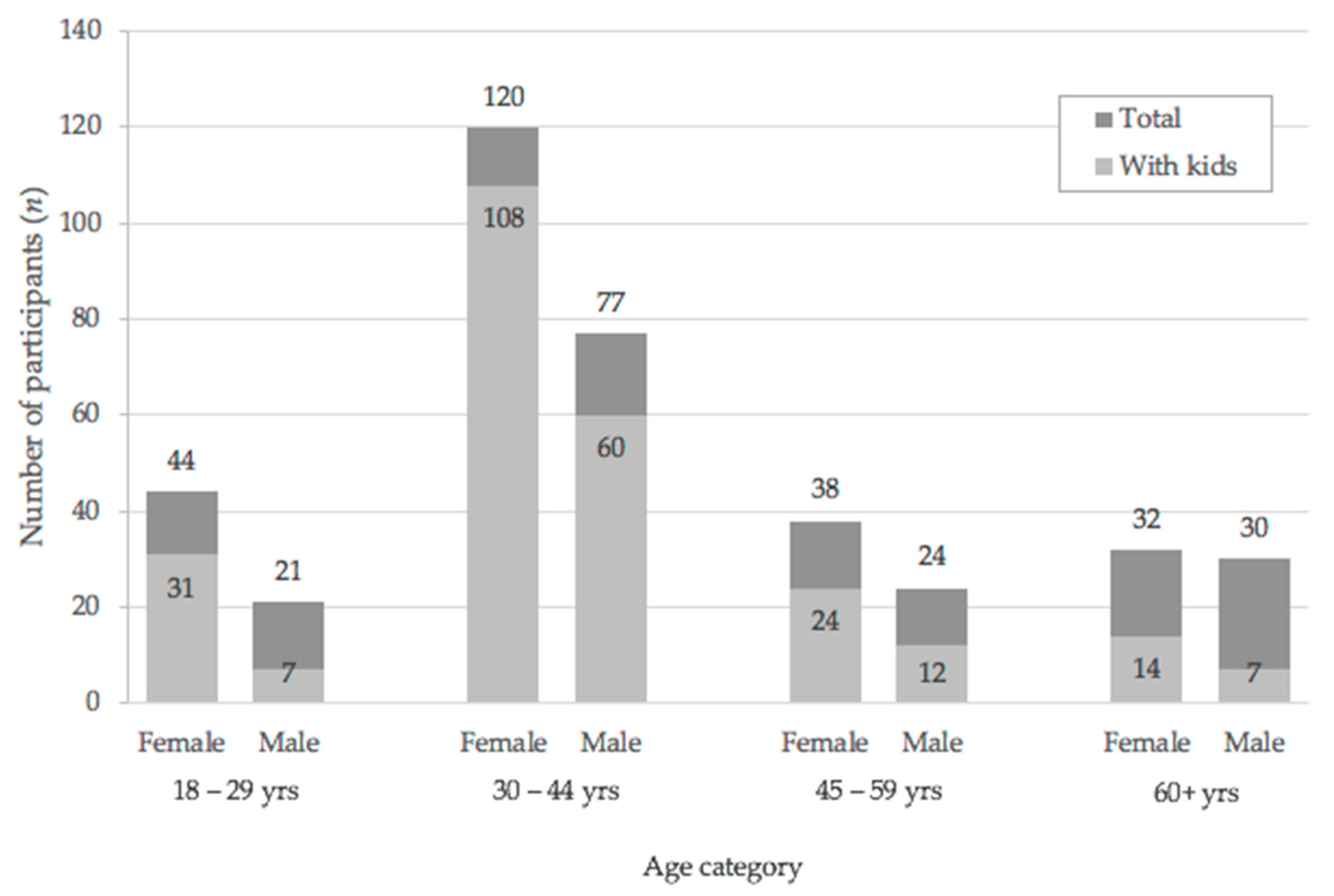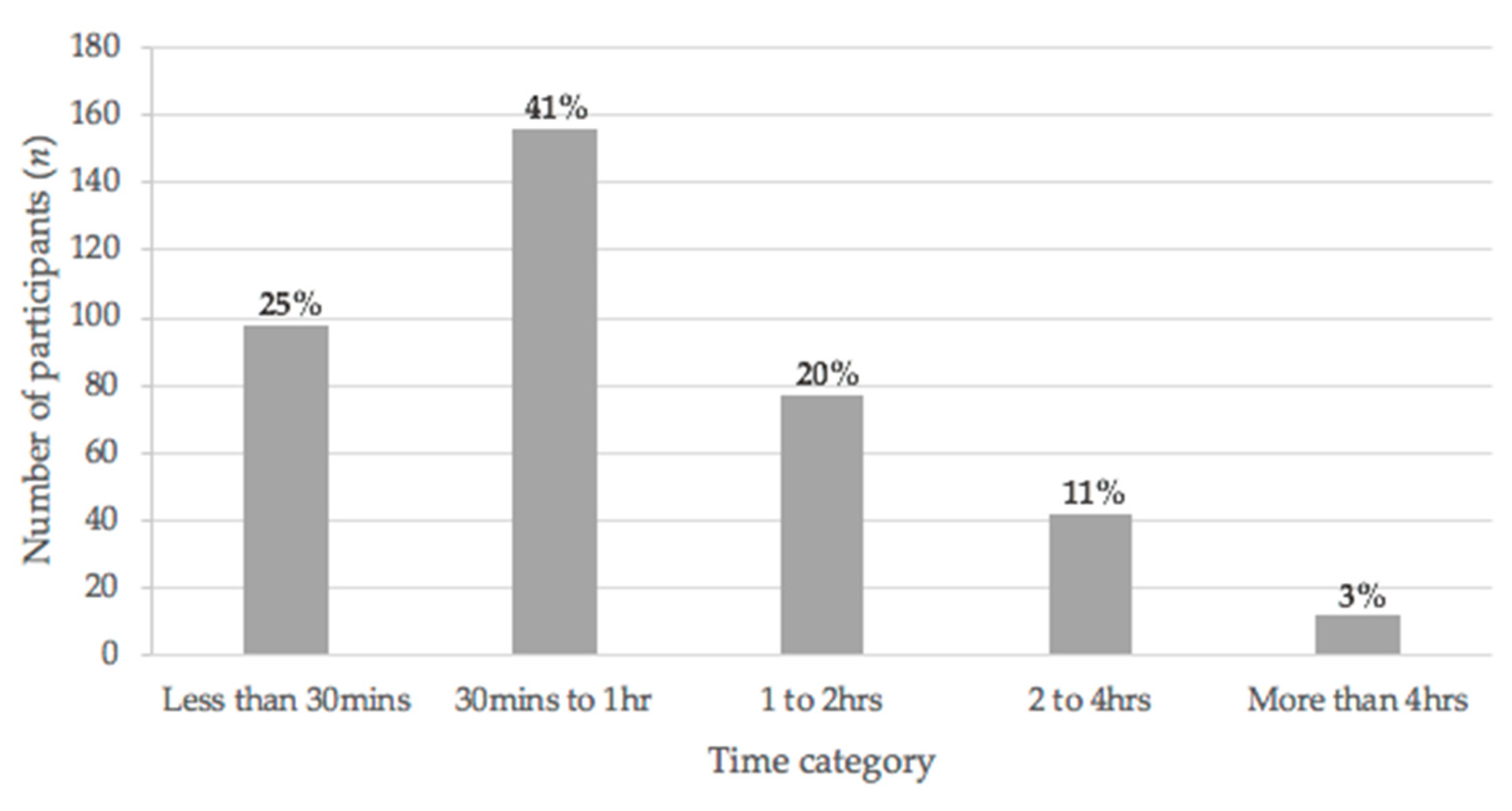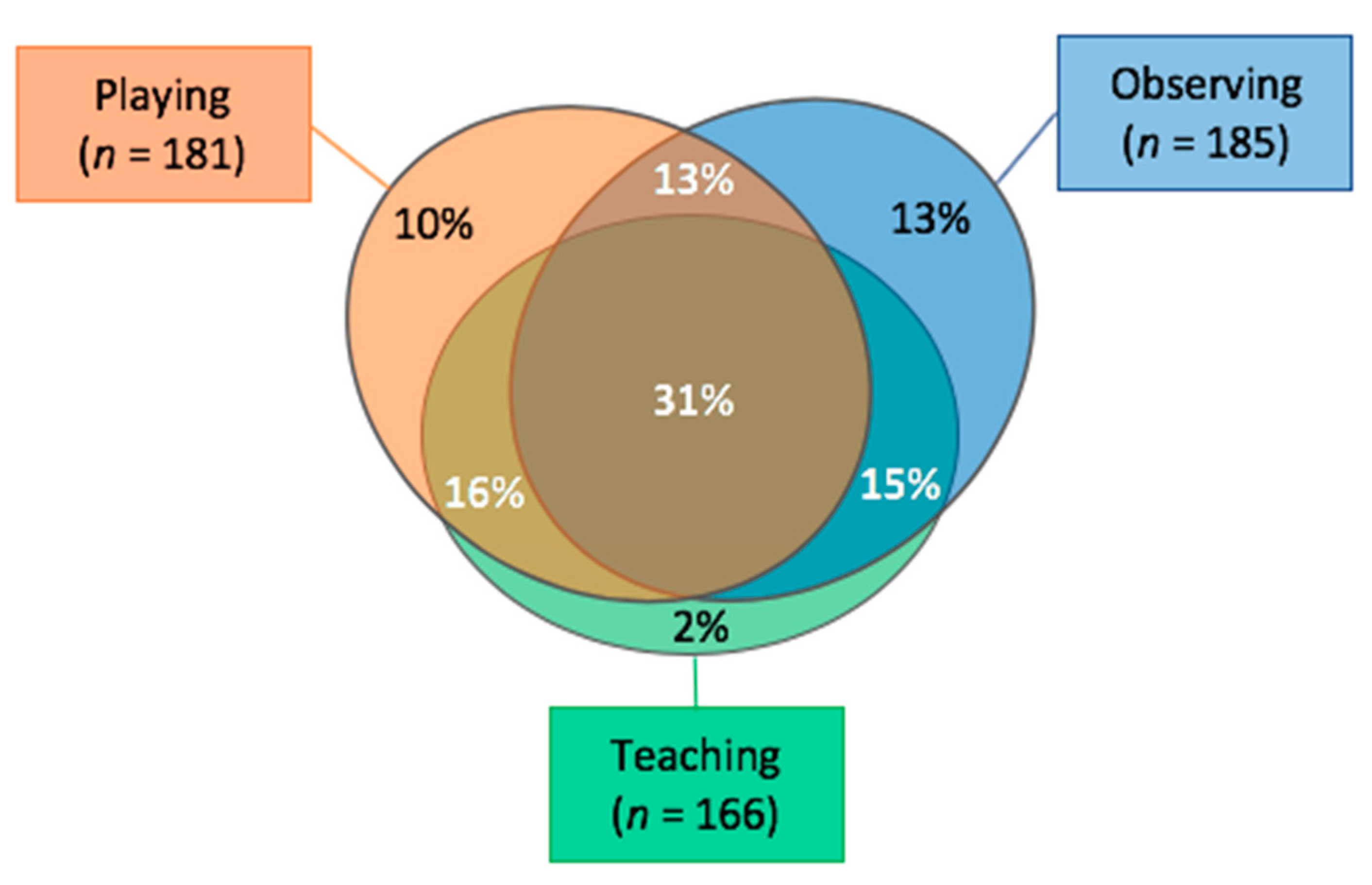Fostering Social Sustainability through Intergenerational Engagement in Australian Neighborhood Parks
Abstract
1. Introduction
1.1. Social Sustainability
1.2. Encouraging Socialization and Physical Activity through Public Parks
1.3. Theory
1.4. Setting
1.5. Aims and Objectives
2. Materials and Methods
2.1. Materials
2.2. Recruitment
2.3. Participants
2.4. Data Treatment
3. Results
3.1. What Intergenerational Interactions Occur in the Park?
3.1.1. Playing
“We play together. We always play with her. We can’t let her just run off by herself. She’s a bit young.”(R405; Girl 0–5 years)
“Play together, I don’t really get to sit and supervise. We’ve got a few more years before that.”(R380; Boy 0–5 years, Girl 0–5years)
3.1.2. Observing
3.1.3. Teaching
“I think one of the best things in the park is like developing their social skills, so they will meet with other kids and they learn to share toys and play together.”(R414)
“I’ve probably been more like trying to instruct him to be careful and sort of watching out for little kids, more than anything else.”(R386)
3.2. What Park Areas Are Being Utilized?
3.2.1. Playground
“The main thing is if you’ve got different variety of different types of play equipment because I know that we’ve taken them to playground parks before when there’s only been two or three different things to play on. He gets bored in half an hour, whereas here he’s quite content just roaming around, different activities, different swings, climbing apparatus, and different colors is always a good thing as well.”(R351)
3.2.2. Open Fields
3.2.3. Pathways
“Well, they’re wide, and they’re fairly recently done, so there’s no tripping traps… Yeah, it’s very evenly—it’s all very nicely done, very smooth walking.”(R274, Age Category: 70 to 74 years)
“Well, you’ve got a path to follow, and at this stage, it’s kept up. […] There’s not many things you can slip over on. It’s pretty safe. When you get a bit older, you need to have something that’s—and they’re wide.”(R253, Age Category: 65 to 69 years)
4. Discussion
5. Conclusions
Author Contributions
Funding
Acknowledgments
Conflicts of Interest
References
- McConnell, J.; Naylor, P.-J. Feasibility of an Intergenerational-Physical-Activity Leadership Intervention. J. Intergener. Relatsh. 2016, 14, 220–241. [Google Scholar] [CrossRef]
- Dempsey, N.; Bramley, G.; Power, S.; Brown, C. The social dimension of sustainable development: Defining urban social sustainability. Sustain. Dev. 2011, 19, 289–300. [Google Scholar] [CrossRef]
- United Nations DoEaSA. United Nations, Inclusive Social Development, 2015. Available online: Un.org/development/desa/dspd/2030agenda-sdgs.html (accessed on 1 March 2019).
- VanderVen, K. Intergenerational theory in society: Building on the past, questions for the future. J. Intergener. Relatsh. 2004, 2, 75–94. [Google Scholar] [CrossRef]
- Woodcraft, S.B.N.; Caistar-Arendar, L.; Hackett, T. Design for Social Sustainability: A Framework for Creating Thriving New Communities; Social-Life: Walworth, London, UK, 2012; Available online: http://www.social-life.co/media/files/DESIGN_FOR_SOCIAL_SUSTAINABILITY_3.pdf (accessed on 1 July 2019).
- MacCallum, J.; Palmer, D.; Wright, P.; Cumming-Potvin, W.; Brooker, M.; Tero, C. Australian Perspectives: Community Building Through Intergenerational Exchange Programs. J. Intergener. Relatsh. 2010, 8, 113–127. [Google Scholar] [CrossRef]
- Kaplan, M.; Haider, J.; Cohen, U.; Turner, D. Environmental Design Perspectives on Intergenerational Programs and Practices. J. Intergener. Relatsh. 2007, 5, 81–110. [Google Scholar] [CrossRef]
- Buffel, T.; De Backer, F.; Peeters, J.; Phillipson, C.; Reina, V.R.; Kindekens, A.; Donder, L.D.; Lombaerts, K. Promoting sustainable communities through intergenerational practice. Procedia Soc. Behav. Sci. 2014, 116, 1785–1791. [Google Scholar] [CrossRef]
- Zeldin, S.; Larson, R.; Camino, L.; O’Connor, C. Intergenerational relationships and partnerships in community programs: Purpose, practice, and directions for research. J. Community Psychol. 2005, 33, 1–10. [Google Scholar] [CrossRef]
- Davidson Knight, A. Funding intergenerational initiatives to strengthen local communities. Qual. Ageing Older Adults 2012, 13, 307–316. [Google Scholar] [CrossRef]
- Young, T.L.; Janke, M.C.; Sharpe, C.; Carthron, D. Evaluating the feasibility of a community intergenerational physical activity intervention for kinship families: Professional stakeholders’ perspectives. Eval. Program Plan. 2019, 72, 136–144. [Google Scholar] [CrossRef]
- Kessler, E.M.; Staudinger, U.M. Intergenerational potential: Effects of social interaction between older adults and adolescents. Psychol. Aging 2007, 22, 690–704. [Google Scholar] [CrossRef]
- Foundation, M. Generations United Present Awards to America’s Best Intergenerational Communities: Today, 8.4 Million People Live in Age-Friendly Communities, Where All Ages Engage in Decision–Making, Problem-Solving and Relationship-Building; PR Newswire Association LLC: New York, NY, USA, 2015; Available online: http://search.proquest.com/docview/1657605164/ (accessed on 1 July 2019).
- Cohen, D.A.; Golinelli, D.; Williamson, S.; Sehgal, A.; Marsh, T.; McKenzie, T.L. Effects of park improvements on park use and physical activity: Policy and programming implications. Am. J. Prev. Med. 2009, 37, 475–480. [Google Scholar] [CrossRef] [PubMed]
- Cohen, D.A.; Marsh, T.; Williamson, S.; Derose, K.P.; Martinez, H.; Setodji, C.; McKenzie, T.L. Parks and physical activity: Why are some parks used more than others? Prev. Med. 2010, 50, S9–S12. [Google Scholar] [CrossRef] [PubMed]
- Solomon, S.G. The Science of Play: How to Build Playgrounds That Enhance Children’s Development; University Press of New England: Lebanon, NH, USA, 2014. [Google Scholar]
- Joseph, R.P.; Maddock, J.E. Observational park-based physical activity studies: A systematic review of the literature. Prev. Med. 2016, 89, 257–277. [Google Scholar] [CrossRef] [PubMed]
- Salvo, D.; Banda, J.A.; Sheats, J.L.; Winter, S.J.; Dos Santos, D.L.; King, A.C. Impacts of a temporary urban pop-up park on physical activity and other individual-and community-level outcomes. J. Urban Health 2017, 94, 470–481. [Google Scholar] [CrossRef] [PubMed]
- Townsend, M.; Henderson-Wilson, C.; Warner, E.; Weiss, L.J.D.U. Healthy Parks Healthy People: The State of the Evidence, 2015. Available online: Parkweb.vic.gov.au/__data/assets/pdf_file/0003/672582/HPHP_state-of-the-evidence_2015.pdf (accessed on 1 March 2019).
- Council, M.B.R. Open Space Strategy 2012–2031. Available online: https://www.moretonbay.qld.gov.au/files/assets/public/services/publications/planning-strategies/open-space-strategy.pdf (accessed on 15 July 2019).
- Van Hecke, L.; Ghekiere, A.; Van Cauwenberg, J.; Veitch, J.; De Bourdeaudhuij, I.; Van Dyck, D.; Clarys, P.; Weghe, N.V.D.; Deforche, B. Park characteristics preferred for adolescent park visitation and physical activity: A choice-based conjoint analysis using manipulated photographs. Landsc. Urban Plan. 2018, 178, 144–155. [Google Scholar] [CrossRef]
- Vaughan, C.A.; Colabianchi, N.; Hunter, G.P.; Beckman, R.; Dubowitz, T. Park Use in Low-Income Urban Neighborhoods: Who Uses the Parks and Why? J. Urban Health 2018, 95, 222–231. [Google Scholar] [CrossRef] [PubMed]
- Refshauge, A.D.; Stigsdotter, U.K.; Cosco, N.G. Adults’ motivation for bringing their children to park playgrounds. Urban For. Urban Green. 2012, 11, 396–405. [Google Scholar] [CrossRef]
- Qazi, H.A. Childhood obesity and parks and playgrounds: A review of issues of equality, gender and social support. J. Res. Med. Sci. 2011, 16, 553–558. [Google Scholar]
- Outley, C.W.; Floyd, M.F. The Home They Live In: Inner City Children’s Views on the Influence of Parenting Strategies on Their Leisure Behavior. Leis. Sci. 2002, 24, 161–179. [Google Scholar] [CrossRef]
- Ries, A.V.; Voorhees, C.C.; Roche, K.M.; Gittelsohn, J.; Yan, A.F.; Astone, N.M. A Quantitative Examination of Park Characteristics Related to Park Use and Physical Activity Among Urban Youth. J. Adolesc. Health 2009, 45, S64–S70. [Google Scholar] [CrossRef]
- Kaplan, M.; Sanchez, M.; Hoffman, J. Intergenerational. Pathways to a Sustainable Society; Ding, M., Ed.; Gewerbestrasse 11, 6330; Springer: Cham, Switzerland, 2017. [Google Scholar]
- Jarrott, S.E. Where have we been and where are we going? Content analysis of evaluation research of intergenerational programs. J. Intergener. Relatsh. 2011, 9, 37–52. [Google Scholar] [CrossRef]
- Hatton-Yeo, A. An introduction to intergenerational practice. Work. Older People 2010, 14, 4–11. [Google Scholar] [CrossRef]
- Gibson, J. The Ecological Approach to Visual Perception of Pictures. Leonardo. 1978, 11, 227–235. [Google Scholar] [CrossRef]
- Norman, D. Affordance, conventions, and design. Interactions 1999, 6, 38–43. [Google Scholar] [CrossRef]
- Heft, H. Affordances and the body: An intentional analysis of Gibson’s ecological approach to visual perception. J. Theory Soc. Behav. 1989, 19, 1–30. [Google Scholar] [CrossRef]
- Thompson, C.W. Activity, exercise and the planning and design of outdoor spaces. J. Environ. Psychol. 2013, 34, 79–96. [Google Scholar] [CrossRef]
- Heft, H. Affordances and the Perception of Landscape: An Inquiry into Environmental Perception and Aesthetics; Taylor & Francis Publishing: London, UK; Routledge: Oxon, UK, 2010; pp. 9–32. [Google Scholar]
- Vojnovic, I.; Jackson-Elmoore, C.; Holtrop, J.; Bruch, S. The renewed interest in urban form and public health: Promoting increased physical activity in Michigan. Cities 2006, 23, 1–17. [Google Scholar] [CrossRef]
- Council, M.B.R. Planning Scheme Policy Residential Design 2015. Available online: https://www.moretonbay.qld.gov.au/files/assets/public/services/building-development/mbrc-plan/psp/v3/residential_design.pdf (accessed on 12 July 2019).
- Flora, P.K.; Faulkner, G.E. Physical Activity: An Innovative Context for Intergenerational Programming. J. Intergener. Relatsh. 2007, 4, 63–74. [Google Scholar] [CrossRef]
- Brown, W.J.; Burton, N.W.; Rowan, P.J. Updating the evidence on physical activity and health in women. Am. J. Prev. Med. 2007, 33, 404–411. [Google Scholar] [CrossRef]
- Moore, R.C.; Cosco, N.G. What Makes a Park Inclusive and Universally Designed?: A Multi-Method Approach; Taylor & Francis: New York, NY, USA, 2007; pp. 105–130. [Google Scholar]



| Park Area | Adults n | % | Park Area | Child/ren n | % |
|---|---|---|---|---|---|
| Playground | 114 | (43.3%) | Playground | 216 | (82.1%) |
| Pathway | 54 | (20.5%) | Open fields | 45 | (17.1%) |
| Open fields | 52 | (19.8%) | Pathway | 36 | (13.7%) |
| Not active | 38 | (14.4%) | Basketball court | 19 | (7.2%) |
© 2019 by the authors. Licensee MDPI, Basel, Switzerland. This article is an open access article distributed under the terms and conditions of the Creative Commons Attribution (CC BY) license (http://creativecommons.org/licenses/by/4.0/).
Share and Cite
Washington, T.L.; Flanders Cushing, D.; Mackenzie, J.; Buys, L.; Trost, S. Fostering Social Sustainability through Intergenerational Engagement in Australian Neighborhood Parks. Sustainability 2019, 11, 4435. https://doi.org/10.3390/su11164435
Washington TL, Flanders Cushing D, Mackenzie J, Buys L, Trost S. Fostering Social Sustainability through Intergenerational Engagement in Australian Neighborhood Parks. Sustainability. 2019; 11(16):4435. https://doi.org/10.3390/su11164435
Chicago/Turabian StyleWashington, Tracy L., Debra Flanders Cushing, Janelle Mackenzie, Laurie Buys, and Stewart Trost. 2019. "Fostering Social Sustainability through Intergenerational Engagement in Australian Neighborhood Parks" Sustainability 11, no. 16: 4435. https://doi.org/10.3390/su11164435
APA StyleWashington, T. L., Flanders Cushing, D., Mackenzie, J., Buys, L., & Trost, S. (2019). Fostering Social Sustainability through Intergenerational Engagement in Australian Neighborhood Parks. Sustainability, 11(16), 4435. https://doi.org/10.3390/su11164435






